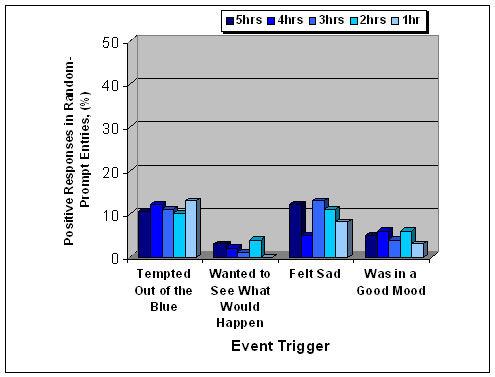Researchers have used ecological momentary assessment (EMA) devices to collect data about the real time activities, moods, and environments of research participants. This data allows investigators to gain a better understanding of the events that precede episodes of drug use. Participants respond to random prompts programmed to appear on the EMA screens at specific times and also initiate their own entries. This week, we review a study about the use of EMA devices to monitor the changes in activity and mood immediately preceding craving for, and use of, cocaine and heroin. In this study, researchers were able to monitor changes in mood and setting by requesting that participants enter information into the EMA devices at different pre-set time intervals as well as at other random intervals. Because there were few heroin-only related events, we limit our report to the cocaine findings (Epstein et al., 2009).
Methods
- Investigators recruited 130 cocaine- and heroin-using outpatients from a methadone treatment research clinic.
- Inclusion criteria: (1) age between 18 and 65 years old; (2) evidence of physical dependence on opiates; (3) evidence of cocaine and opiate use.
- Exclusion criteria: (1) DSM-IV psychotic disorders; (2) current dependence on alcohol or any sedative hypnotic drug; (3) cognitive impairment precluding informed consent; (4) medical illness compromising study participation
- Participants enrolled in a program that included:
- Daily methadone injections (target dose 100mg/day), 7 days/week for up to 20 weeks
- Urine drug tests 3 times/week
- Abstinence reinforcement in the form of vouchers for weeks 7-18
- At the end of week 3, participants in the program received EMA configured PDAs
- Random prompts were timed to occur during participants’ expected waking hours: 5 random prompts per day for 5 weeks, then 2 random prompts per day for 20 weeks
- Participants also could initiate their own entry when they craved and/or used heroin and/or cocaine
- At each random prompt or participant initiated entry, participants reported where they were, what they were doing, with whom, and answered questions about their mood
- Randomly prompted entries assessed craving and lapse triggers
- Each question began “Within the past hour I felt …”, ended with triggers statements (listed below), and was answered with yes or no
- Triggers items: “Saw Drug”, “Was Offered Drug”, “Wanted to See What Would Happen”, “Tempted Out of the Blue”, “Handled $10 in Cash”, “Felt Worried”, “Felt Angry”, “Felt Worried”, “Felt Sad”, “Felt Criticized by Others”, “Was in a Good Mood”, and “Felt Uncomfortable”
- Researchers analyzed the randomly prompted entries of 102 participants (those who provided enough data) at each of the 5 hours preceding each event-contingent entry. Repeated-measures logistic regressions, with hours before use as the within-subject independent variable, determined whether the patterns of reported triggers changed significantly over time. Investigators analyzed the craving and use events separately.
Results
- Overall, participants carried PDAs for a total of 14,918 personal-days (mean: 130.9 days per participant) and answered 78.4% of randomly issued prompts (26,969 out of 34,400) and initiated 2,500 event entries (mean: 21.0 per participant). Participants responded to 1,555 randomly prompted entries during the 5 hours before episodes of craving or/and use.
- All triggers were significantly associated with cocaine use (all p < 0.05), but only “Saw Drug”, “Felt Worried”, and “Felt Criticized by Others” were significantly associated with cocaine craving (all p < 0.05).
- A comparison of positive responses to the following putative triggers showed a significant difference between cocaine use and craving (see Figures 1 and 2). “Wanted to See What Would Happen”, “Tempted Out of the Blue”, “Felt Sad”, and “Was in a Good Mood” produced large linear cocaine use increases (all p < 0.001), but not for cocaine craving.
Figure 1: Percent endorsing triggers before cocaine craving event by hours before CRAVING (adapted from Epstein et al., 2009) (all P < 0.001). 
Figure 2: Percent endorsing triggers before cocaine use event by hours before USE (adapted from Epstein et al., 2009) (not significant at α=0.05 level).
Limitations
o Researchers did not examine the effects of environment, acquaintances, and activities.
o It’s possible that random prompts from EMA devices had damaging effects.
o The participants, methadone patients, are not representative of most drug users.
Conclusions
The use of ecological momentary assessment (EMA) technology presents possibilities for both research and clinical work. Epstein et al.’s study shows that drug abusers can be trusted with electronic devices (only one PDA was lost or damaged for every 226 person-days of use) and will use them as instructed. EMA device use allows researchers to use the recorded data to better understand the acute daily triggers that lead to drug use and craving. These EMA devices have the potential to change our understanding of pre-use and pre-craving events and lead to the development of better relapse prevention and treatment methods that can target specific precursors to individual drug use. Furthermore, it is possible to use these devices in clinical settings, so the treatment methods can be tailored to patients’ day-to-day lives by analyzing the data from EMA device use over a shorter period of time.
What do you think? Comments can be addressed to Ingrid R Maurice
References
Epstein, D. H., Willner-Reid, J., Vahabzadeh, M., Mezghanni, M., Lin, J. L., & Preston, K. L. (2009). Real-time electronic diary reports of cue exposure and mood in the hours before cocaine and heroin craving and use. Arch Gen Psychiatry, 66(1), 88-94.



